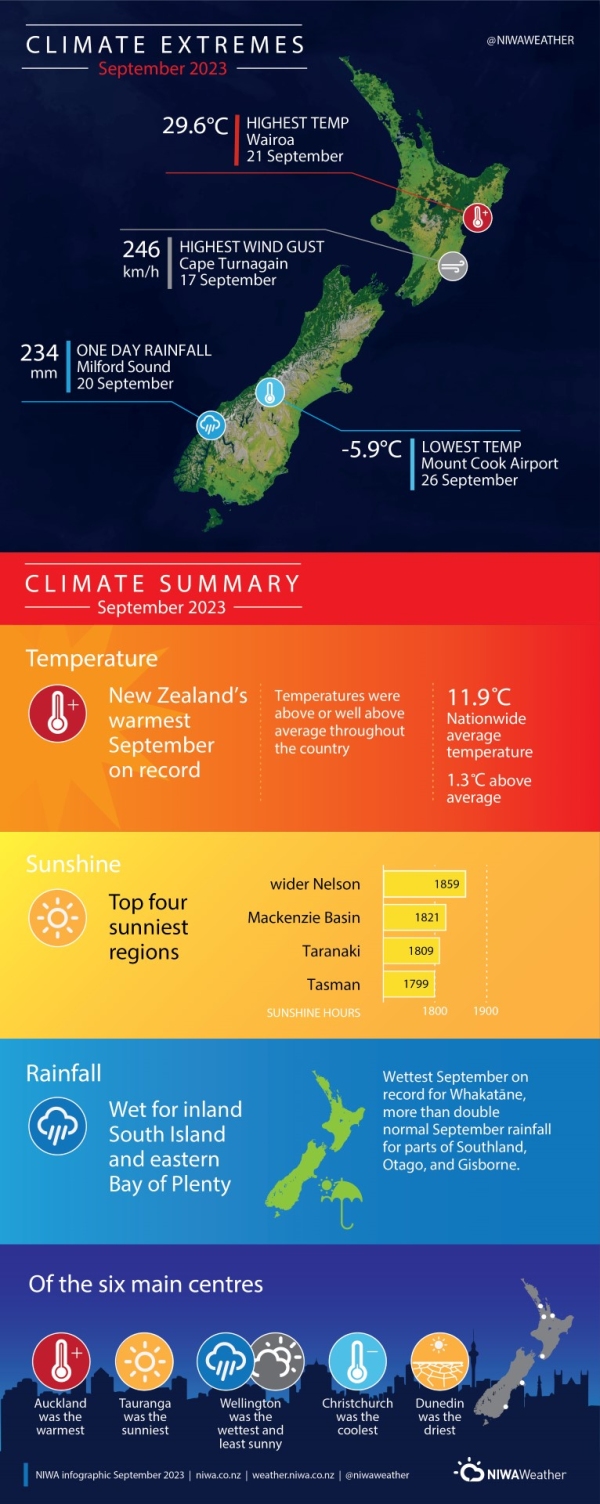New Zealand’s warmest September on record
|
Temperature |
Temperatures were above average (0.51°C to 1.20°C above average) or well above average (>1.20°C above average) in every region of the country. The nationwide average temperature was 1.3°C above the 1991-2020 September average, making it the country’s warmest September on record. |
|
Rainfall |
Rainfall was above normal (120-149% of normal) or well above normal (>149% of normal) in parts of Southland, Otago, Canterbury, coastal Wairarapa, Gisborne, Bay of Plenty, Waikato, and Auckland. Rainfall was below normal (50-79% of normal) in parts of the Hutt Valley, Kāpiti Coast, Manawatū-Whanganui, southern Hawke’s Bay, and Banks Peninsula. |
|
Soil Moisture |
At the end of the month, soil moisture levels were higher than normal for the time of year in eastern and inland parts of Otago and Canterbury, and coastal parts of Wairarapa and Gisborne. Soil moisture levels were typically near normal for most remaining parts of New Zealand. |
Overview
The nationwide average temperature in September 2023 was 11.9°C. This was 1.3°C above the 1991-2020 September average, making it Aotearoa New Zealand’s warmest September since NIWA’s seven station temperature series began in 1909 . Temperatures were above average (0.51°C to 1.20°C above average) or well above average (>1.20°C above average) throughout Aotearoa New Zealand. A period of exceptionally high temperatures for early spring were recorded from 20-21 September (see Highlights and extreme events section for details). This included a maximum temperature of 29.6°C in Wairoa, which is the highest September temperature on record for the North Island, and New Zealand’s third-highest September temperature on record.
September 2023 was characterised by higher than normal mean sea level pressure (MSLP) over Aotearoa New Zealand, but especially over and to the east and west of the North Island. This produced more westerly and northwesterly airflows than normal, particularly over the South Island. High pressure systems were most prevalent over the country during the first half of the month, delivering a period of relatively benign weather for many areas. The second half of September became more unsettled, with several frontal systems contributing to very strong westerly and northwesterly wind events, which are a hallmark of early spring weather patterns in New Zealand. By the end of September, an El Niño event was declared, and this climate driver was a likely contributor to the persistent westerly and northwesterly winds observed during the latter half of the month.
Rainfall was above normal (120-149% of normal) or well above normal (>149% of normal) in parts of Southland, Otago, Canterbury, coastal Wairarapa, Gisborne, Bay of Plenty, Waikato, and Auckland. The majority of rainfall recorded in these areas occurred in the second half of the month, when several heavy rainfall events delivered record or near-record high daily rainfall totals to 19 locations across the North and South Islands (see Highlights and extreme events section). In contrast, rainfall was below normal (50-79% of normal) in parts of the Hutt Valley, Kāpiti Coast, Manawatū-Whanganui, southern Hawke’s Bay, and Banks Peninsula. Rainfall was typically near normal (80-119% of normal) for the remainder of the country.
Further Highlights
- The highest September temperature was 29.6°C, observed at Wairoa on 21 September.
- The lowest September temperature was -5.9°C, observed at Mount Cook Airport on 26 September.
- The highest 1-day rainfall was 234 mm, recorded at Milford Sound on 20 September.
- The highest wind gust was 246 km/h, observed at Cape Turnagain on 17 September.
- Of the six main centres in September 2023, Auckland was the warmest, Tauranga was the sunniest, Dunedin was the driest, Wellington was the wettest and least sunny, and Christchurch was the coolest.
- Of the available, regularly reporting sunshine observation sites, the sunniest four regions in 2023 so far are wider Nelson (1859 hours), Mackenzie Basin (1821 hours), Taranaki (1809 hours), and Tasman (1799 hours).

Download
Climate summary September 2023 [596KB]

